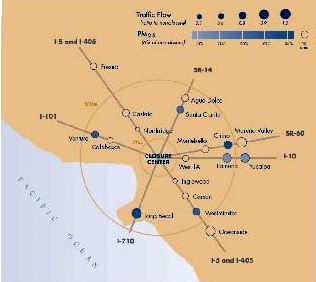Also discussed here: Air Quality Results of a Freeway Closure (5 page pdf, Arthur Winer, Yifang Zhu, and Suzanne Paulson, ACCESS, Jun. 2014)
Today we review the quantitative improvement in air quality that results from temporary closure of a heavily used freeway in southern California. Before and after measurements of air pollutants indicate as much as a 83% reduction during the period it was closed. The authors strongly recommend that steps be taken to reduce roadside pollution from freeways in future by limiting the use of single occupancy vehicles and to convert electrically powered vehicles. Almost make one wonder who came up with the idea of freeways to start with and, more to the point, why run these “pollution sewers” through urban centres where people have to breathe the resulting pollution! Vancouver is the only major city in North America that I can think of that does NOT have a freeway running through its centre - they must have clever urban planners there!

Key Quotes:
“Opportunities to directly quantify the relationship between vehicle emissions and air quality by investigating effects of large scale, rapid reductions in traffic are rare. .. during the 1996 Olympic Games in Atlanta, peak traffic decreased by around 20 percent and ozone fell by nearly 30 percent”
“During the 2008 Olympic and Paralympic Games in Beijing, the Chinese government enacted air pollution-reducing policies, including traffic restrictions, that resulted in significant reductions in near-roadway emissions”
“In August 2008, New York City closed Park Avenue to vehicular traffic on three consecutive Saturdaymornings to promote clean air. This resulted in 58 percent lower ultrafine particle concentrations in the near-roadway environment during the closures. ”
“In July 2011, Interstate 405, one of the busiest freeways in the United States, was closed for two days as part of a freeway improvement project….On the first day of the closure, there was a 90 percent reduction in traffic on the I-405 at Constitution Avenue compared with a normal Saturday. Similar to the Los Angeles, Atlanta, and Beijing Olympics, the extreme traffic congestion, or in this case “Carmageddon,” never happened.”
“The first day of the freeway closure, was the easiest day to get around Los Angeles in decades. Indeed, from a driving standpoint and from an air quality perspective, the term “Carmaheaven” turned out to be more appropriate.”
“Compared to the post-closure period, downwind areas experienced an 83 percent reduction in ultrafine particles, 55 percent less PM2.5, and 62 percent less black carbon during the closure period.Using the region’s air monitoring network, we observed that over the entire South Coast Air Basin, PM2.5 was reduced 18 to 36 percent, depending on proximity to the closure”
Two approaches that would improve air quality in southern California:
• “transportation policies and alternatives to single-occupancy automobile traffic could be developed to drastically reduce vehicle miles traveled.
• there could be widespread adoption of super ultralow- and zero-emission vehicles.”





No comments:
Post a Comment